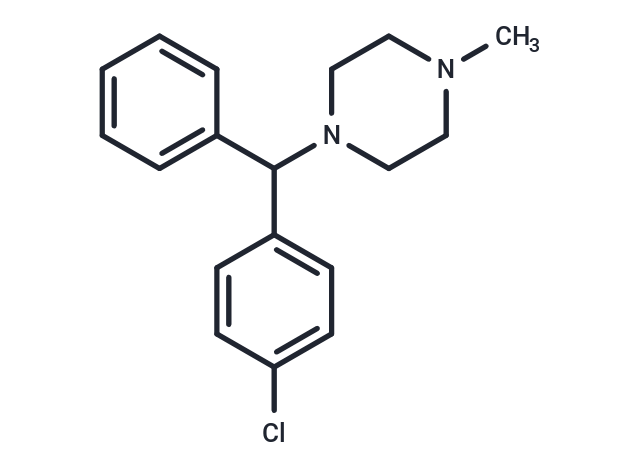Shopping Cart
- Remove All
 Your shopping cart is currently empty
Your shopping cart is currently empty

CHLORCYCLIZINE is a histamine H1 antagonist and a potent hepatitis C virus (HCV) entry inhibitor.

| Pack Size | Price | Availability | Quantity |
|---|---|---|---|
| 10 mg | $30 | In Stock | |
| 25 mg | $44 | In Stock | |
| 50 mg | $61 | In Stock | |
| 100 mg | $109 | In Stock | |
| 1 mL x 10 mM (in DMSO) | $98 | In Stock |
| Description | CHLORCYCLIZINE is a histamine H1 antagonist and a potent hepatitis C virus (HCV) entry inhibitor. |
| In vivo | Pregnant rats were administered 30, 60, or 90 mg/kg CHLORCYCLIZINE on Gestation Days 11 to 14. Fetal palate gene expression was also assessed after 90 mg/kg CHLORCYCLIZINE at 8, 15 and 30 hours post-dose on Gestation Day 14 using microarray and qRT-PCR. Rats in the 60- and 90-mg/kg groups exhibited adverse clinical signs and body weight loss. Rats in the 90-mg/kg group also demonstrated increases in late resorptions and decreases in fetal weight. Effects in the low-dose group were limited to decreases in body weight gain. Fetal assessment on Gestation Day 21 revealed that findings were limited to the 60- and 90-mg/kg groups, and included cleft palate (80% of litters for both groups), high arched palate, small nose, micrognathia, high domed head, digits shortened/absent and small limb. The fetal incidence of cleft palate was higher at 90 mg/kg, thus this dose was selected to assess palate gene expression. The altered genes associated with CHLORCYCLIZINE-induced cleft palate included Wnt5a, Bmp2, Bmp4, Fgf10, Fgfr2, Msx1, and Insig1 but the magnitude of the change was relatively small (1.5- to 2-fold)[1]. |
| Molecular Weight | 300.83 |
| Formula | C18H21ClN2 |
| Cas No. | 82-93-9 |
| Smiles | C(C1=CC=C(Cl)C=C1)(N2CCN(C)CC2)C3=CC=CC=C3 |
| Storage | Powder: -20°C for 3 years | In solvent: -80°C for 1 year | Shipping with blue ice. | |||||||||||||||||||||||||||||||||||
| Solubility Information | DMSO: 50 mg/mL (166.21 mM), Sonication is recommended. | |||||||||||||||||||||||||||||||||||
Solution Preparation Table | ||||||||||||||||||||||||||||||||||||
DMSO
| ||||||||||||||||||||||||||||||||||||

Copyright © 2015-2025 TargetMol Chemicals Inc. All Rights Reserved.